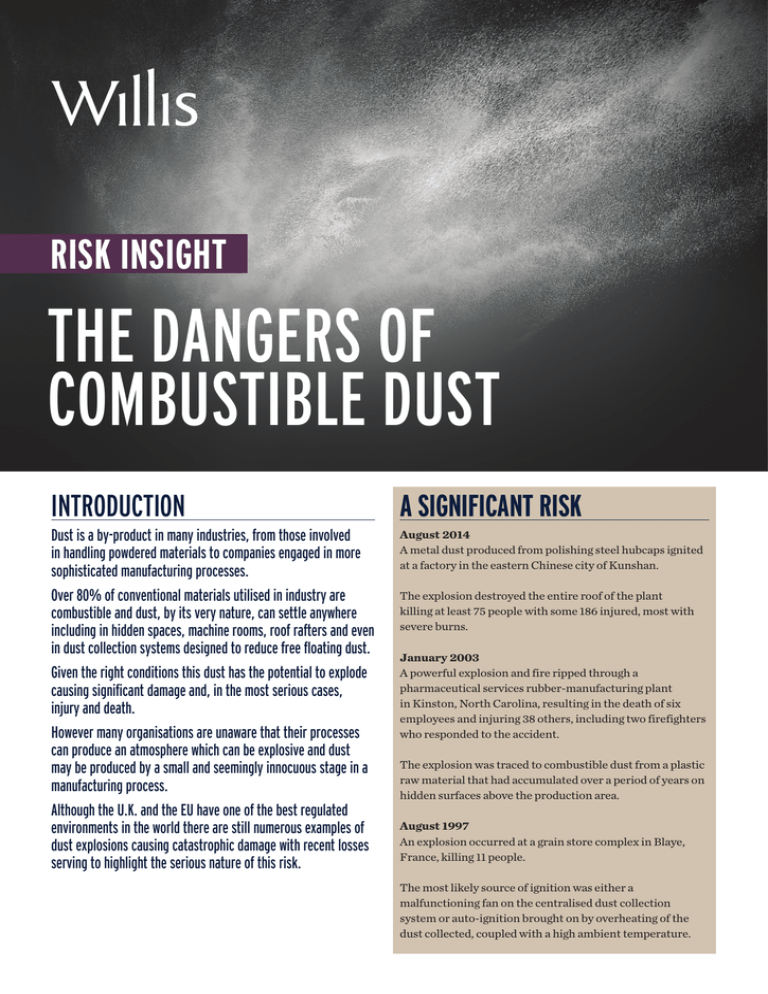
RISK INSIGHT
THE DANGERS OF
COMBUSTIBLE DUST
INTRODUCTION
A SIGNIFICANT RISK
Dust is a by-product in many industries, from those involved
in handling powdered materials to companies engaged in more
sophisticated manufacturing processes.
Over 80% of conventional materials utilised in industry are
combustible and dust, by its very nature, can settle anywhere
including in hidden spaces, machine rooms, roof rafters and even
in dust collection systems designed to reduce free floating dust.
Given the right conditions this dust has the potential to explode
causing significant damage and, in the most serious cases,
injury and death.
However many organisations are unaware that their processes
can produce an atmosphere which can be explosive and dust
may be produced by a small and seemingly innocuous stage in a
manufacturing process.
Although the U.K. and the EU have one of the best regulated
environments in the world there are still numerous examples of
dust explosions causing catastrophic damage with recent losses
serving to highlight the serious nature of this risk.
August 2014
A metal dust produced from polishing steel hubcaps ignited
at a factory in the eastern Chinese city of Kunshan.
The explosion destroyed the entire roof of the plant
killing at least 75 people with some 186 injured, most with
severe burns.
January 2003
A powerful explosion and fire ripped through a
pharmaceutical services rubber-manufacturing plant
in Kinston, North Carolina, resulting in the death of six
employees and injuring 38 others, including two firefighters
who responded to the accident.
The explosion was traced to combustible dust from a plastic
raw material that had accumulated over a period of years on
hidden surfaces above the production area.
August 1997
An explosion occurred at a grain store complex in Blaye,
France, killing 11 people.
The most likely source of ignition was either a
malfunctioning fan on the centralised dust collection
system or auto-ignition brought on by overheating of the
dust collected, coupled with a high ambient temperature.
The risk of dust explosion exists in a wide range of industries including, but not limited to:
Agriculture (e.g. sugar, spice, starch, flour, animal feed)
Fertilizer
Chemicals
Plastics
Tobacco
Forest
Wood
Rubber
Paper/pulp
Textiles
Furniture
Pharmaceuticals
Pesticides
Dyes
Plastics
Metal processing, including aluminium, chromium, iron,
magnesium, and zinc
Coal
Waste recycling
Power generation (e.g. coal)
HOW DO DUST EXPLOSIONS OCCUR?
A dust explosion will only occur when the following conditions
are satisfied:
1. The dust is combustible
2. The dust is airborne
3. Particle size is capable of propagating combustion
4. Concentration of dust is within the materials explosion limits
5.Dust makes contact with an ignition source sufficient to
propagate flame
6. Oxygen content is sufficient to support combustion
WHAT MAKES DUST EXPLOSIONS SO DAMAGING?
When a dust cloud ignites in an enclosed space it results in a very rapid
rise in pressure.
An initial explosion will likely stir up other dust deposits causing a
secondary explosion that is generally more destructive than the first.
HOW CAN BUSINESSES MINIMISE THE POSSIBILITY OF DUST
RELATED EXPLOSIONS?
The Dangerous Substances and Explosive Atmospheres Regulations
2002 set out the minimum requirements for improving health and safety
protection within potentially explosive atmospheres through the safe
handling and use of dangerous substances.
MINIMISING THE IMPACT OF A DUST EXPLOSION
It is not always possible to completely eliminate
the risk of dust related explosions.
To minimise the impact of any explosion
protective and relief systems will be needed
to halt an incipient explosion immediately or
to mitigate the effects.
Measures include:
– Elimination of sparks
– Isolation of dusty operations and equipment
– Explosion vents
– Elimination of foreign (tramp) material
– Earthing of equipment and accessories
HOW WILLIS CAN HELP
Willis’ team of risk advisors have a detailed
understanding of the risks associated with dust
in the workplace and knowedge of the best and
most appropriate risk mitigation strategies.
To find out more please contact your local
Willis representative.
They place an obligation on employers to:
– Identify where explosive atmosphere conditions occur.
– Assess the risk and record what actions are being taken to prevent an
explosion and fire.
Full details of the regulations are available from the HSE at:
http://www.hse.gov.uk/fireandexplosion/dsear.htm
This publication offers a general overview of its subject matter. It does not necessarily address every aspect of its subject or every product available in the market. It is not intended
to be, and should not be, used to replace specific advice relating to individual situations and we do not offer, and this should not be seen as, legal, accounting or tax advice. If you
intend to take any action or make any decision on the basis of the content of this publication you should first seek specific advice from an appropriate professional. Some of the
information in this publication may be compiled from third party sources we consider to be reliable, however we do not guarantee and are not responsible for the accuracy of such.
The information given in this publication is believed to be accurate at the date of publication shown at the bottom of this document. This information may have subsequently
changed or have been superseded, and should not be relied upon to be accurate or suitable after this date. The views expressed are not necessarily those of the Willis Group.
Copyright Willis Limited 2014. All rights reserved.
Willis Limited, Registered number: 181116 England and Wales. Registered address: 51 Lime Street, London EC3M 7DQ. A Lloyd’s Broker. Authorised and regulated by the
Financial Conduct Authority for its general insurance mediation activities only.
FP1737/13477/09/14



